 W
WThe 500 Hats of Bartholomew Cubbins is a children's book, written and illustrated by Theodor Geisel under the pen name Dr. Seuss and published by Vanguard Press in 1938. Unlike the majority of Geisel's books, it is written in prose rather than rhyming and metered verse. Geisel, who collected hats, got the idea for the story on a commuter train from New York to New England, while he was sitting behind a businessman wearing a hat; the passenger was so stiff and formal that Geisel idly wondered what would happen if he took the man's hat and threw it out the window. Geisel concluded that the man was so "stuffy" that he would just grow a new one.
 W
WAnd to Think That I Saw It on Mulberry Street is Theodor Seuss Geisel's first children's book published under the pen name Dr. Seuss. First published by Vanguard Press in 1937, the story follows a boy named Marco, who describes a parade of imaginary people and vehicles traveling along a road, Mulberry Street, in an elaborate fantasy story he dreams up to tell his father at the end of his walk. However, when he arrives home he decides instead to tell his father what he actually saw—a simple horse and wagon.
 W
WBartholomew and the Oobleck is a 1949 book by Dr. Seuss. It follows the adventures of a young boy named Bartholomew Cubbins, who must rescue his kingdom from a sticky green substance called "oobleck." The book is a sequel of sorts to The 500 Hats of Bartholomew Cubbins. Unlike most of Geisel's books, which are written in anapestic tetrameter, Bartholomew and the Oobleck is a prose work, like its predecessor.
 W
WThe Bippolo Seed and Other Lost Stories is a collection of seven illustrated stories by children's author Dr. Seuss published by Random House on September 27, 2011. Though they were originally published in magazines in the early 1950s, they had never been published in book form and are quite rare, described by the publisher as "the literary equivalent of buried treasure". The stories were discovered by Charles D. Cohen, a Massachusetts dentist and a Seuss scholar and biographer, who also contributed an introduction to the collection.
 W
WThe Butter Battle Book is a rhyming story written by Dr. Seuss. It was published by Random House on January 12, 1984. It is an anti-war story; specifically, a parable about arms races in general, mutually assured destruction and nuclear weapons in particular. The Butter Battle Book was a New York Times Notable Book of the Year.
 W
WThe Cat in the Hat Comes Back is a 1958 children's book written and illustrated by Dr. Seuss and published by Random House. In this book, a sequel to The Cat in the Hat (1957), the chaos-causing title character leaves a pink stain in the family bathtub, which spreads around the house as the children try to get rid of it, until the cat unveils a series of increasingly small cats from beneath his hat, the smallest of which resolves the problem.
 W
WThe Cat in the Hat is a 1957 children's book written and illustrated by the American author Theodor Geisel, using the pen name Dr. Seuss. The story centers on a tall anthropomorphic cat who wears a red and white-striped hat and a red bow tie. The Cat shows up at the house of Sally and her brother one rainy day when their mother is away. Despite the repeated objections of the children's fish, the Cat shows the children a few of his tricks in an attempt to entertain them. In the process, he and his companions, Thing One and Thing Two, wreck the house. The children and the fish become more and more alarmed until the Cat produces a machine that he uses to clean everything up and disappears just before the children's mother comes home.
 W
WThe Cat's Quizzer is a children's book written and illustrated by Theodor Geisel under the pen name Dr. Seuss and published by Random House on August 12, 1976.
 W
WCome over to My House is a 1966 children's book written by Dr. Seuss and illustrated by Richard Erdoes. The name "Theo. LeSieg" was a pen name of Theodor Geisel, who is more commonly known by another pen name, Dr. Seuss.
 W
WDaisy-Head Mayzie is a children's book written by Dr. Seuss and illustrated in his style. It was published in 1995, as Seuss's first posthumous book. It was republished on July 5, 2016, with Seuss's original text and drawings.
 W
WDr. Seuss's ABC is a 1963 children's A to Z alphabetical picture book by Dr. Seuss. It was published as part of the Random House Beginner Books series. It contains several short poems about a variety of characters, and is designed to introduce basic alphabet book concepts to children.
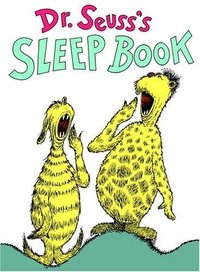 W
WDr. Seuss's Sleep Book, commonly referred to as The Sleep Book, is a children's book written by Dr. Seuss in 1962. The story centers on the activity of sleep as readers follow the journey of many different characters preparing to slip into a deep slumber. This book documents the different sleeping activities that some of the creatures join in on: Jo and Mo Redd-Joff participate in competitive sleep talking and a group “near Finnigan Fen” enjoys group sleepwalking. It opens with a small bug, named Van Vleck, yawning. This single yawn sets off a chain reaction, effectively putting “ninety-nine zillion nine trillion and two” creatures to sleep.
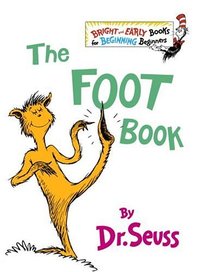 W
WThe Foot Book is a children's book written by Dr. Seuss and first published in 1968, “And renewed in 1996” The Foot Book is intended for young children, and it seeks to convey the concept of opposites through depictions of different kinds of feet. The text of The Foot Book is highly stylized, containing the rhymes, repetitions, and cadences typical of Dr. Seuss's work.
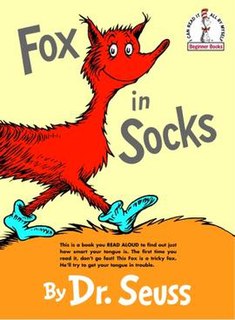 W
WFox in Socks is a children's book by Dr. Seuss, first published in 1965. It features two main characters, Fox who speaks almost entirely in densely rhyming tongue-twisters and Knox who has a hard time following up Fox's tongue-twisters until the end.
 W
WGreat Day for Up! is a book written by Dr. Seuss and illustrated by Quentin Blake. It was published by Random House on August 28, 1974.
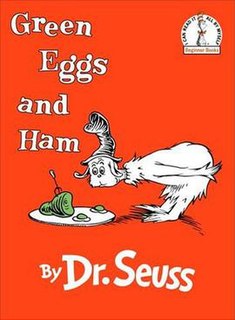 W
WGreen Eggs and Ham is a children's book by Dr. Seuss, first published on August 12, 1960. As of 2019, the book has sold 8 million copies worldwide. The story has appeared in several adaptations, starting with 1973's Dr. Seuss on the Loose starring Paul Winchell as the voice of both Sam-I-Am and the first-person narrator, Guy-Am-I, and more recently an animated TV series of the same name on Netflix starring the voices of Adam DeVine as Sam and Michael Douglas as Guy.
 W
WHappy Birthday to You! is a 1959 children's book by Dr. Seuss, the first all-color picture book.
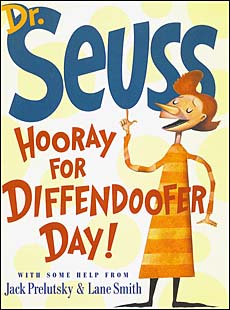 W
WHooray for Diffendoofer Day! is a children's book credited to Dr. Seuss "with some help from Jack Prelutsky and Lane Smith". The book is based on verses and sketches created by Seuss before his death in 1991, and was expanded to book length and completed by writer Prelutsky and illustrator Smith for publication in 1998.
 W
WHop on Pop (ISBN 978-0-394-80029-5) is a 1963 children's picture book by Dr. Seuss. It was published as part of the Random House Beginner Books series, and is subtitled "The Simplest Seuss for Youngest Use". It contains several short poems about a variety of characters, and is designed to introduce basic phonics concepts to children.
 W
WHorse Museum is a Dr. Seuss book released by Random House Children's Books on September 3, 2019. It is based on an unfinished manuscript by Theodor Seuss Geisel completed by Australian illustrator Andrew Joyner. 250,000 copies were released of the first printing.
 W
WHorton and the Kwuggerbug and More Lost Stories is an anthology of children's stories written and illustrated by Dr. Seuss, published posthumously by Random House in 2014.
 W
WHorton Hatches the Egg is a children's book written and illustrated by Theodor Geisel under the pen name Dr. Seuss and published in 1940 by Random House. The book tells the story of Horton the Elephant, who is tricked into sitting on a bird's egg while its mother, Mayzie, takes a permanent vacation to Palm Beach. Horton endures a number of hardships but persists, often stating, "I meant what I said, and I said what I meant. An elephant's faithful, one hundred percent!" Ultimately, the egg hatches, revealing an elephant-bird, a creature with a blend of Mayzie's and Horton's features.
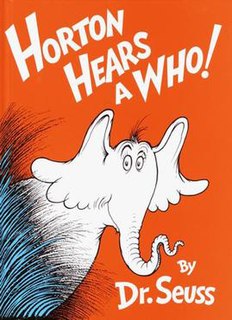 W
WHorton Hears a Who! is a children's book written and illustrated by Theodor Seuss Geisel under the pen name Dr. Seuss. It was published in 1954 by Random House. This book tells the story of Horton the Elephant and his treacherous adventures saving Whoville, a tiny planet located on a small speck of dust, from the evil animals who mock him. These animals attempt to steal and burn the speck of dust, so Horton goes to great lengths to save Whoville from being incinerated. The book is written in the typical Dr. Seuss rhyme pattern.
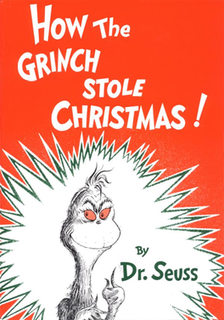 W
WHow the Grinch Stole Christmas! is a children's story by Theodor "Dr. Seuss" Geisel written in rhymed verse with illustrations by the author. It follows the Grinch, a grumpy, solitary creature who attempts to put an end to Christmas by stealing Christmas-themed items from the homes of the nearby town Whoville on Christmas Eve. Miraculously, the Grinch realizes that Christmas may not all be about money and presents.
 W
WHunches in Bunches is a children's book written and illustrated by Theodor Geisel under the pen name Dr. Seuss and published by Random House on October 12, 1982.
 W
WI Am NOT Going to Get Up Today! is a children's book written by Theodor Geisel under the pen name Dr. Seuss. It is illustrated by James Stevenson and was published by Random House on October 12, 1987.
 W
WI Can Lick 30 Tigers Today! and Other Stories is a 1969 children's story book by Dr. Seuss. According to the inside cover, the stories concern The Cat in the Hat's son/childhood, daughter/sister, and great-great-grandfather. The title story concerns The Cat in the Hat's son/childhood, who brags that he can fight 30 tigers and win. He makes excuse after excuse, finally disqualifying all the tigers until he must fight no tigers at all. The illustrations are notable for their use of gouache and brush strokes rather than the usual pen and ink. Others stories include "King Looie Katz", another warning against hierarchical society advocating self-reliance, and "The Glunk That Got Thunk" about the power of run-away imagination. Illustrations for "The Glunk That Got Thunk" make great use of wavy line crosshatching.
 W
WI Can Read with My Eyes Shut! is a children's book written and illustrated by Theodor Geisel under the pen name Dr. Seuss and first published by Random House on November 12, 1978. In the book, the Cat in the Hat shows his son Young Cat the fun he can get out of reading, and also shows that reading is a useful way of gaining knowledge.
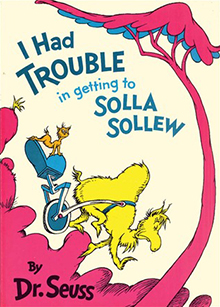 W
WI Had Trouble in Getting to Solla Sollew is a 1965 children's book by Dr. Seuss. The story features classic Seuss rhymes and drawings in his distinctive pen and ink style.
 W
WI Wish That I Had Duck Feet is a children's book written by Dr. Seuss, illustrated by B. Tobey, and first published in 1965. "Theo. LeSieg" was a pen name of Theodor Geisel, who is more commonly known as Dr. Seuss. The story is about a boy who wishes that he could have many different animal and mechanical body parts. For each body part, he finds fantastic uses for them, as well as their problematic aspects. At the end, he decides that he is happiest being himself.
 W
WIf I Ran the Circus is a children's book by Dr. Seuss, published in 1956 by Random House.
 W
WIf I Ran the Zoo is a children's book written by Dr. Seuss in 1950.
 W
WThe King's Stilts is a children's book written and illustrated by Theodor Geisel under the pen name Dr. Seuss, and first published in 1939 by Random House. Unlike many Dr. Seuss books, it is narrated in prose rather than verse.
 W
WThe Lorax is a children's book written by Dr. Seuss and first published in 1971. It chronicles the plight of the environment and the Lorax, who "speaks for the trees" and confronts the Once-ler, who causes environmental destruction. As in most Dr. Seuss works, most of the creatures mentioned are original to the book.
 W
WMarvin K. Mooney Will You Please Go Now! is a 1972 children's book by Dr. Seuss. Written as a book for early beginning readers, it is suitable for children who can not yet read at the level of more advanced beginning books such as The Cat in the Hat. The book presents, in short and funny fashion, Dr. Seuss's nonsensical words, rhymes, and illustrations. In the book, Marvin K. Mooney is asked to "go" ; "go" with many ways. The narrator is an unseen individual. His voice is heard, but he is not seen.
 W
WMcElligot's Pool is a children's book written and illustrated by Theodor Geisel under the pen name Dr. Seuss and published by Random House in 1947. In the story, a boy named Marco, who first appeared in Geisel's 1937 book And to Think That I Saw It on Mulberry Street, imagines a wide variety of strange fish that could be swimming in the pond in which he is fishing.
 W
WMy Book about ME is a children's book written by Theodor Geisel under the pen name Dr. Seuss and first published by Random House on September 12, 1969.
 W
WMy Many Colored Days is a children's book written by Theodor Geisel under the pen name Dr. Seuss.
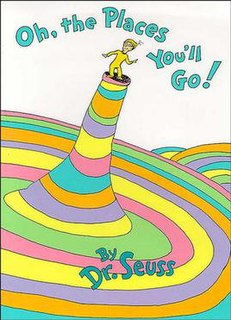 W
WOh, the Places You'll Go! is a book written and illustrated by children's author Dr. Seuss. It was first published by Random House on January 22, 1990. It was his last book to be published during his lifetime. The book concerns the journey of life and its challenges.
 W
WOh, the Thinks You Can Think! is a children's book written and illustrated by Theodor Geisel under the pen name Dr. Seuss and published by Random House on August 21, 1975. The book is about the many amazing 'thinks' one can think and the endless possibilities and dreams that imagination can create.
 W
WOn Beyond Zebra! is a 1955 illustrated children's book by Theodor Geisel, better known as Dr. Seuss. In this boundary-pushing take on the genre of alphabet book, Seuss presents, instead of the twenty-six letters of the conventional English alphabet, twenty additional letters that purportedly follow them.
 W
WOne Fish, Two Fish, Red Fish, Blue Fish is a 1960 children's book by Dr. Seuss. As of 2001, over 6 million copies of the book had been sold, placing it 13th on a list of "All-Time Bestselling Children's Books" from Publishers Weekly. Based on a 2007 online poll, the United States' National Education Association labor union listed the book as one of its "Teachers' Top 100 Books for Children."
 W
WThe Pocket Book of Boners is a book illustrated by Theodor Seuss Geisel, originally published as four separate books in 1931–32 by The Viking Press. In 1941, Readers' League of America compiled these four books and published the Pocket Book of Boners. It was one of the bestselling paperback books of World War II, with 1.34 million copies in print by 1945. At the time of its writing, the term "boner" was not commonly used to mean an erection, with sexual connotation, but rather as a term meaning "silly mistake".
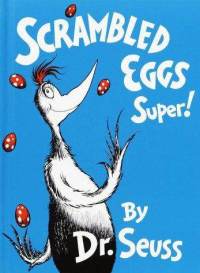 W
WScrambled Eggs Super! is a 1953 book by American children's author Dr. Seuss. The story is told from the point of view of a boy named Peter T. Hooper, who makes scrambled eggs prepared from eggs belonging to various exotic birds.
 W
WThe Seven Lady Godivas: The True Facts Concerning History's Barest Family is a picture book of the tale of Lady Godiva, written and illustrated by Dr. Seuss. One of Seuss's few books written for adults, its original 1939 publication by Random House was a failure and was eventually remaindered. However, it later gained popularity as Seuss himself grew in fame, and was republished in 1987.
 W
WThe Shape of Me and Other Stuff is a children's book written and illustrated by Theodor Geisel under the pen name Dr. Seuss and published by Random House on July 12, 1973.
 W
WThe Sneetches and Other Stories is a collection of stories by American children's author Dr. Seuss, published in 1961. It is composed of four separate stories with themes of tolerance, diversity, and compromise: "The Sneetches", "The Zax", "Too Many Daves", and "What Was I Scared Of?". Based on a 2007 online poll, the National Education Association listed the book as one of its "Teachers' Top 100 Books for Children." In 2012 it was ranked number 63 among the "Top 100 Picture Books" in a survey published by School Library Journal – the fifth of five Dr. Seuss books on the list.
 W
WThere's a Wocket in My Pocket is a short children's book by Dr. Seuss, published by Random House in 1974. It features a little boy talking about the strange creatures that live in his house, such as the yeps on the steps, the nooth grush on his toothbrush, the wasket in his basket, the zamp in a lamp, the yottle in the bottle, and the Nureau in the bureau.
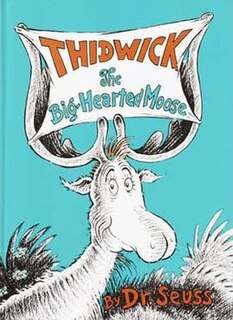 W
WThidwick the Big-Hearted Moose is a 1948 children's book by Dr. Seuss.
 W
WWacky Wednesday is a book for young readers, written by Dr. Seuss as Theo. LeSieg and illustrated by George Booth. It has forty-eight pages, and is based around a world of progressively wackier occurrences where kids can point out that there is a palm tree growing in the toilet, an earthworm chasing a robin, a airplane flying backward, and a traffic light showing that green is stop and red is go, as a few examples.
 W
WWhat Pet Should I Get? is a Dr. Seuss children's book, posthumously published in 2015. Believed to have been written between 1958 and 1962, the book chronicles the adventures of Jay and Kay from Seuss' One Fish, Two Fish, Red Fish, Blue Fish in their attempts to buy a pet.
 W
WYertle the Turtle and Other Stories is a picture book collection by Theodor Seuss Geisel, published under his more commonly known pseudonym of Dr. Seuss. It was first released by Random House Books on April 12, 1958, and is written in Seuss's trademark style, using a type of meter called anapestic tetrameter. Though it contains three short stories, it is mostly known for its first story, "Yertle the Turtle", in which the eponymous Yertle, king of the pond, stands on his subjects in an attempt to reach higher than the moon—until the bottom turtle burps and he falls into the mud, ending his rule.
 W
WYou're Only Old Once! A Book for Obsolete Children is a 1986 picture book for adults by Dr. Seuss, released on Geisel's 82nd birthday,.